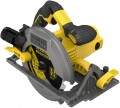Power
Saw motor power in watts. For petrol tools (see "Power Source"), horsepower is additionally indicated, see below for details.
The higher the power, the better the tool is suitable for voluminous work and hard materials, the greater the depth of cut it can provide and the easier it can cope with significant loads. In addition, for different types of saws and different types of materials, the actual power values \u200b\u200bcan also be different. For example, a power of
2.5 – 3 kW is actually the limit for
chain saws, but in
chain saws this is an average figure, among such tools there are models of
3 – 4 kW and even
more. Detailed selection recommendations for various cases can be found in special sources.
Bore diameter
The diameter of the mounting hole for which the blade holder in the saw of the corresponding design is designed (see "Device"). In fact, this paragraph indicates the diameter of the axis on which the disk is installed — this size should correspond to the hole in the disk itself.
Note that some models of saws allow the installation of discs with larger holes than indicated in the specifications — when using an adapter sleeve. The main thing is that the own diameter of the disk does not exceed the values \u200b\u200ballowed for this model (see "Tyre / disk diameter"). Popular sizes include
20mm,
25mm and
30mm.
Cutting depth
The greatest depth of cut provided by the saw.
In most types of saws (see “Device”), the depth of cut directly depends on both the engine power and the size of the tyre / disk. The specifications give a value for the maximum allowable size of the working nozzle; when using nozzles of a smaller size, the depth of cut, respectively, will be less. But in band saws, this depth is rather weakly related to the actual length of the tape — it is determined primarily by the length of the open section of the tape, which is directly involved in the work.
Anyway, the greater depth of cut makes the tool more versatile, but comes at the cost of weight, price, and electricity/fuel consumption. So when choosing, it is worth considering the real features of the planned work and the dimensions of the workpieces that are planned to be cut. As for specific values, the most modest tools provide a depth
of up to 50 mm ;
50 – 75 mm is considered a low indicator,
75 – 100 mm is average,
100 – 125 mm is above average,
125 – 150 mm is already quite an impressive thickness, and the most powerful modern saws can have a cutting depth
of more than 150 mm.
Noise level
The noise level produced by the saw during operation. Note that this parameter is rather approximate, because in fact, the “loudness of the work” depends not only on the tool, but also on the material being processed and the characteristics of the environment. Nevertheless, the data given in the characteristics make it possible to assess the comfort of working with the tool. The lower this indicator, the less discomfort the noise will cause, and at high values, even special hearing protection may be needed.
Note that the noise level is usually measured in decibels, and this unit is not linear: for example, a difference of 3 dB corresponds to a difference of 2 times, 10 dB — to 10 times. Therefore, it is easiest to evaluate the noise level using comparative tables. Here is a simplified version of such a table for the range in which modern saws operate:
70 dB — loud conversation of several people in close proximity;
75 dB — a cry in the immediate vicinity;
80 dB — truck engine, mechanical alarm ringing;
85 dB — loud scream;
90 dB — freight car at a distance of 7 – 10 m;
95 dB — subway car at a distance of 7 – 10 m;
100 dB — industrial shop;
110 dB — tractor engine;
120 dB — demolition hammer, thunder from a close lightning strike (pain threshold of auditory perception).

